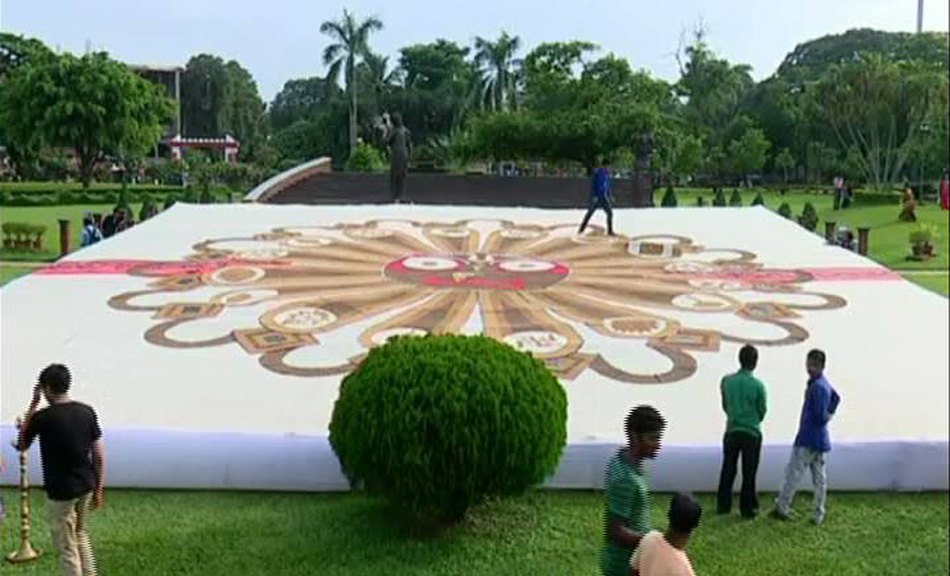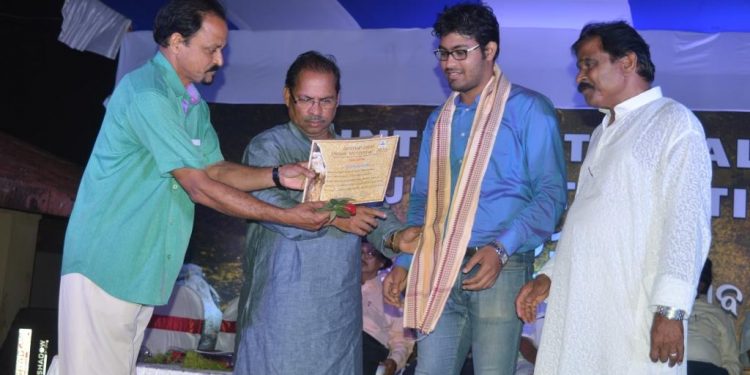Biswakant Panda had never dreamt of making a career in visual arts. In fact, he had a strong dislike for painting. However, destiny had different plans. Two incidents changed his life forever. Today, Biswakant is a painter par excellence and has won accolades for his works across the state. Biswakant, who found a place in the Limca Book of World Records for designing the world’s biggest rakhi in 2015, spoke to Orissa POST on his journey from an art hater to becoming an accomplished painter.
“I was in Class VI when I failed in my half-yearly examinations, as I scored poorly in drawing. During those days, drawing was a subject and a teacher would be assigned to impart training on the basics of painting. I was the only student who failed in drawing. My class teacher requested our arts teacher to give me pass marks, as I had fared well in other subjects. However, he didn’t keep my class teacher’s request. This incident created an impact on me and I started taking drawing seriously,” says Biswakant.
After completing Class X, Biswakant chose to pursue Commerce in Plus II. It was during this time that he came across painter Chintamani Biswal and started learning painting from him. “He was impressed with my works and advised me to enroll myself in an art college. Without a second thought, I decided to quit studies and took admission in BK College of Arts & Crafts,” he says.
In the initial three years, Biswakant took more interest in animation. However, when he was in final year, another incident changed his life forever. “A few students from my batch were ragging newcomers when I confronted them. An argument started and one of my batch mates, who was a brilliant artist, even threatened that he will avenge me by scoring higher marks in the final exams. I felt insulted in front of the juniors and took it as a challenge. That year, I received the Divyaranjan Pani award for my work from the college principal. The award is given to a final-year student for the best artwork in the college,” he adds.

That said, it wasn’t easy for Biswkant to carve a niche in the world of visual arts. “I was among the top 15 students in my college who qualified for government scholarship. That helped me bear the expenses of my studies. After I passed out from BK College of Arts & Crafts, I got into 3D animation and stall designing to eke out a living. My uncle had thrown out my parents from our house owing to family dispute and we even had to spend a night at Giri Durga Temple. I had a difficult childhood. I used to save money from my start-up business to fund my post graduation course in Applied Art at Utkal University of Culture,” he says.
Ask him how he came up with the idea of making the world’s biggest rakhi, and Biswakant says, “In 2015, I thought of making rakhis with rice grain. I made six big rakhis and put them up for sale. Although the others rakhis made with plastic and fabrics were sold out, there were no takers for the ones made with rice grain. Interestingly, on the eve of Rakhi Purnima, few people came and parked their car in front of my stall. They glanced at my shop and were impressed with the handmade rakhis and immediately bought them all. I sold each piece for Rs 150. Following that, I decided to make the world’s biggest rakhi. I approached university authorities and a few ministers for financial aid, but no one helped. Finally, my friends helped me financially and I came up with the world’s biggest rakhi,” says Biswakant.
Earlier, a 40-foot high rakhi was made on Raksha Bandhan by Brahma Kumaris, which was till then the biggest. Biswakant’s rakhi was 500 feet in length and 50 feet in width, and was made of rice grain and paddy. He decided to apply for an entry in the Limca Book of Records. Following this, his creation was certified as the world’s largest rakhi by the Limca Book of Records.
“I had conceptualised it a year ago. It took three quintals of paddy and 40 kilograms of rice grain to make the rakhi. Inaugurated at Indira Gandhi Park in Bhubaneswar, the rakhi was on display for public for three days. My work was appreciated by art lovers from different parts of the country. I was felicitated at the National Youth Festival held at Chandigarh,” he says.
Biswakant, who is an admirer of ad guru Piyush Pandey and painter Prasanna Jyoti, owes his success to his parents Srimati and Nirmal Charan Panda. “I was inspired by my mother in particular. Her artwork during Manabasa Lakhmi Puja has inspired me a lot since childhood,” says Biswakant.






































